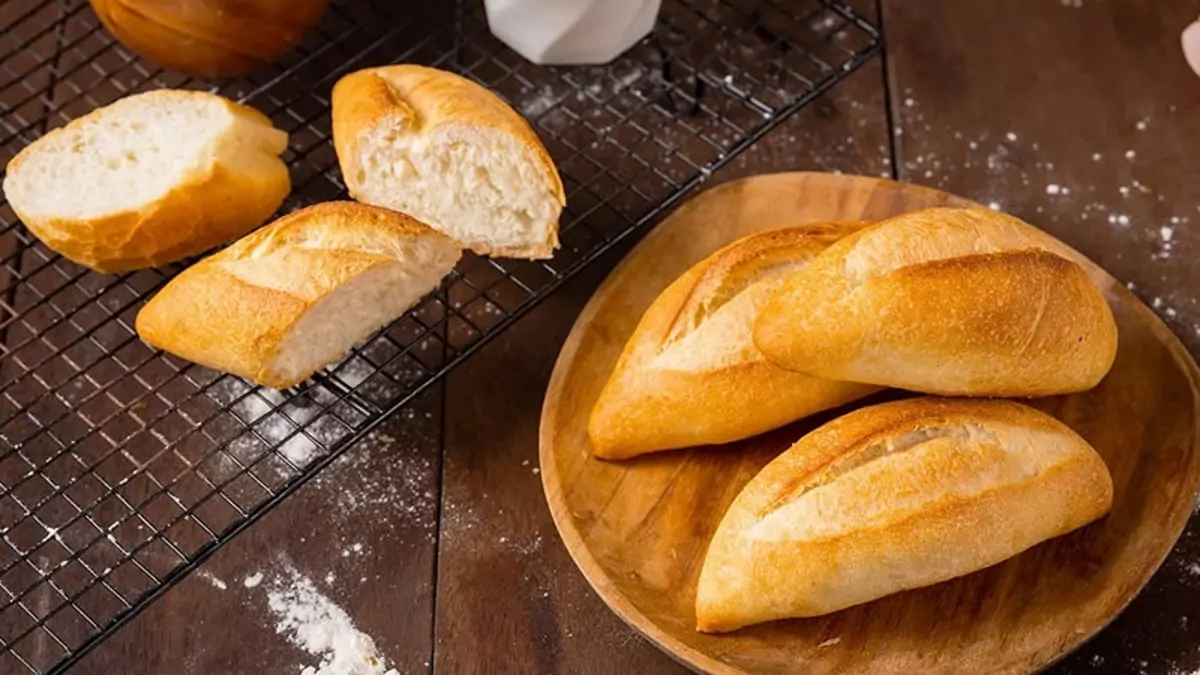Banh mi and pho are two dishes in the culinary dictionary that any foreigner must try when visiting Vietnam. The following tips will help you learn how to make delicious and quick Vietnamese baguettes with easily accessible ingredients.
One of the most common everyday foods you can see on the streets and in every corner of Vietnam is banh mi. With skillful creativity, the Vietnamese people have transformed banh mi by combining it with a variety of enticing fillings. In this article, FoodVietnamese.com will share with you a recipe for making Vietnamese baguettes with a delightful flavor.
How to Make Vietnamese Baguette Without Baking Powder
Ingredients and Tools:
- 300g all-purpose flour
- 5g yeast
- 15g sugar
- A pinch of salt
- 200ml water
- 0.1g vitamin C powder
- 5g vinegar
Baking tools include a dough mixer if available, an oven or microwave, and a baking pot…

How to Mix and Knead Dense Baguette Dough
- Add 300g of all-purpose flour to a mixture of yeast, vitamin C powder, and vinegar, then mix well using a mixer or by hand until the dough is white and risen. Let the dough rest for 20 to 30 minutes.
- Remove the dough from the bowl and proceed to knead it. If using a machine, select a low speed because too high a speed can affect the dough’s rising process. Then knead again by hand, beating the dough until it is smooth and can be stretched. If kneading by hand, place the dough on a flat surface, gather and beat it, using the back of your hand to press and push the dough out. When the dough is smooth, elastic, and can be stretched thin, it is ready.
- Shape the dough into a ball to release some air, let it rest for 5 minutes, then roll it out into a thin circle. Use a knife to cut it into equal pieces, 6 or 8 as desired, and roll each piece into a long, slender shape with slightly pointed ends.
- Continue to let it rise for about 60 minutes, covering it with a damp cloth. The rising time depends on the room temperature; the higher the temperature, the faster the dough will rise.

Instructions for Baking Dense Baguette
After the dough has risen, use a sharp knife to make a lengthwise slash on the bread, and spray some water on the slashed area. Place a tray of boiling water on the lowest rack of the oven, preheat the oven to 180 degrees Celsius for about 10 minutes. Once the oven is hot, arrange the shaped dough on a baking tray and place it in the oven. Bake for about 20 minutes at 170 degrees Celsius. When done, take the bread out and check if it is evenly golden. Brush a layer of butter on the bread while it’s still hot to enhance the aroma.
After baking, you can place the bread in a sealed plastic bag or a ziplock bag to keep it from becoming soft and to maintain its crispiness. The best time to consume the baguette is within 2-3 days to ensure it remains soft and crispy. Keeping it longer may cause it to become chewy and less enjoyable.
How to Make Baguette Using an Air Fryer
Ingredients and Tools:
- 280g all-purpose flour
- 5g yeast
- 20ml peanut butter or cooking oil
- 170ml unsweetened fresh milk or warm water
- 5g salt
- 25g sugar
Tools include an air fryer, a large bowl, a spoon…

Mixing and Proofing the Dough
- Pour 280g of all-purpose flour, 3g of salt, 3g of yeast, 10g of butter, and 10ml of cooking oil into a bowl and mix well. You should not add salt directly to the yeast; instead, mix the flour and yeast first, then add the salt. Any leftover yeast can be stored in a plastic or glass container, sealed tightly, and kept in the refrigerator. Avoid opening the lid frequently. It is best to use the yeast within 6 months and not to use expired yeast for baking.
- Gradually add 165ml of fresh milk to the mixing flour, continuing to mix until the dough is cohesive, not too wet or too dry.
- Lightly knead the dough into a ball with your hands, then transfer it to a table and knead using the stretch-and-fold technique. Use the back of your hand to push the dough away, rotate it 90 degrees, and repeat the process until the dough is smooth, elastic, and forms a uniform mass.
- Cover the bowl of dough with plastic wrap and let it proof for about 1 hour until it doubles in size.
- Take the dough out, roll it into a long shape, and divide it into about 7 portions. Flatten each piece, roll it up, and shape the ends into pointed tips.
- Continue to cover the dough and let it proof for another 30 minutes until it rises. Use a razor blade to make a lengthwise slash along the dough.
Instructions for Baking Bread Using an Air Fryer
- Preheat the air fryer for 5 minutes at 180 degrees Celsius.
- Line the bottom of the fryer with parchment paper, place the bread inside, and spray a mist of water on the dough to prevent it from drying out.
- Bake for 20 minutes at 180 degrees Celsius, then flip the bread and bake for another 5 minutes. Every 10 minutes of baking, open the air fryer to check if the bread meets your desired outcome, as baking time and temperature may vary depending on the air fryer model.
The finished bread will be dense, crispy, and deliciously hot. When you take a bite, you’ll experience the crispiness of the outer crust and the soft, tender crumb inside.

How to Recognize When Bread Dough is Ready
For those kneading bread dough for the first time, it can be challenging to determine if the dough is ready. Here are some signs to help you know if the dough has been kneaded correctly:
- The dough is smooth and elastic.
- It doesn’t stick to your hands; initially, it may feel slightly sticky when you press it, but it doesn’t leave any residue on your fingers when you pull them away.
- You can stretch the dough into a thin membrane without it tearing.
Hopefully, these tips have helped you learn how to make simple and convenient Vietnamese bread at home quickly. Visit Foodvietnamese.com daily to discover more traditional Vietnamese recipes to diversify your family’s meals and nutrition!
